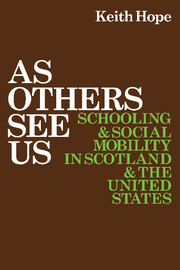Book contents
- Frontmatter
- Contents
- Acknowledgments
- Introduction
- 1 Scotland: A meritelective system?
- 2 Comparison of Scotland with England and Wales
- 3 Comparison of Scotland with the United States
- 4 IQ + effort = merit
- 5 The institutions of managed meritelection
- 6 Was selection carried out fairly?
- 7 Meanings of key terms
- 8 Does deprivation affect life chances?
- 9 Market situation
- 10 Intelligence and occupational mobility
- 11 Intelligence and vertical mobility
- 12 Scottish society
- 13 Understanding other people's norms
- 14 Merit or desert?
- Notes
- References
- Index
6 - Was selection carried out fairly?
Published online by Cambridge University Press: 05 February 2012
- Frontmatter
- Contents
- Acknowledgments
- Introduction
- 1 Scotland: A meritelective system?
- 2 Comparison of Scotland with England and Wales
- 3 Comparison of Scotland with the United States
- 4 IQ + effort = merit
- 5 The institutions of managed meritelection
- 6 Was selection carried out fairly?
- 7 Meanings of key terms
- 8 Does deprivation affect life chances?
- 9 Market situation
- 10 Intelligence and occupational mobility
- 11 Intelligence and vertical mobility
- 12 Scottish society
- 13 Understanding other people's norms
- 14 Merit or desert?
- Notes
- References
- Index
Summary
Wide variations in practice among local education authorities make it impossible to generalize about the degree of meritelection in England and Wales before the 1944 act. The main determinants of competition for grammar school places were these: the number and proportion of places open to competition; the extent to which financial help was given; the number of middle-class parents who sent their children to public elementary school whence they could compete for free grammar school places; whether children from private primary schools were allowed to compete; the employment situation in the area; and whether or not a reputable central school provided an acceptable alternative to the local grammar school.
Allocation of social resources
Although discrepancies among areas in the proportion of grammar school places available to a cohort of children continued to exist, the act was a signal for a move toward greater institutional uniformity throughout the country. Such a move had already taken place in Scotland, and it may be for that reason that it was in Scotland that the selection tests were devised which were to be used by many local education authorities in England and Wales when they required a defensible means for deciding the educational fate of children. This was an era in which local government was forced to adopt universalistic rules for allocation of social resources both because of the large number of people to whom they had to be applied and because the work of the Labour party in the wartime coalition government had accustomed the people to demand and expect equity in social organization.
- Type
- Chapter
- Information
- As Others See UsSchooling and Social Mobility in Scotland and the United States, pp. 86 - 121Publisher: Cambridge University PressPrint publication year: 1985
- 1
- Cited by



